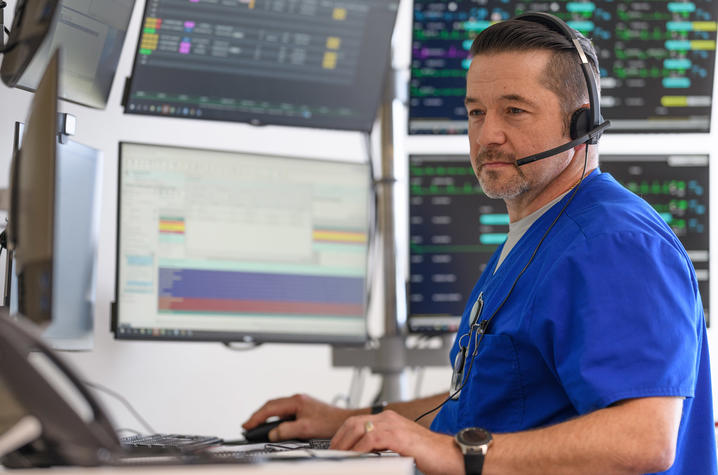eCAT ICU Provides Extra Eyes During Critical Times

LEXINGTON, Ky. (June 2, 2020) – A team of critical care nurses work around the clock to monitor patients’ vital signs, review lab results, and assist care teams with urgent assessments, all from an unassuming office building in University of Kentucky’s Coldstream Research Park, miles from UK Chandler Hospital.
This is the home of UK HealthCare’s Enhanced Care through Advanced Technology Intensive Care Unit (eCAT ICU), the only facility of its kind in Kentucky. A team of specially trained nurses and physicians provide support to nurses working directly with patients, using advanced surveillance technology to monitor critical patients and interpret clinical algorithms and protocols that can detect changes in a patient’s status earlier in real time.
Royal Philips, a global leader in health technology, and UK HealthCare, announced a collaboration to create Kentucky’s only operating clinical command center for tele-critical care and operational optimization earlier this year. Leveraging Philips’ acute telehealth platform, eCareManager, the academic medical center is implementing a centralized virtual care model to help providers detect risk of patient deterioration so they can intervene earlier and help improve care outcomes for the organization’s sickest patients.
Philips’ eICU Program is built around eCareManager, which uses advanced analytics and AI to synthesize patient data and deliver actionable insights to support proactive care. Using this comprehensive system, UK HealthCare provides 24/7 remote monitoring and access to specialists for patients in the neurological, trauma, surgery, post-anesthesia care, medical intensive care, emergency department and cardiovascular patient care venues.
“The goal of the eCAT ICU is not to replace or compete with the bedside teams, but to be an additional resource that can supplement the current plan of care,” said Dr. Anthony Bottiggi, medical director of the eCAT ICU and surgical critical care.
The eCAT ICU nurses have critical care backgrounds and can help bedside providers with monitoring patients, reviewing charts and lab results, and providing visual assessments via video. These measures can reduce a patient’s hospital stay as they would otherwise have to wait for an onsite nurse or physician to make those assessments.
“We are crisis prevention instead of crisis intervention,” said eICU nurse Morgan Freedman. “We use an integrated approach of technology, data collection and critical care trained nurses to provide an added layer of monitoring for our ICU patients. We have prevented falls, alerted staff to a patient that had fallen and prevented patients from self-extubations.”
“We’re an extra resource for the on-site staff,” said eCAT ICU nurse Anna Allen. “When I was a bedside nurse, one of the things that I wish I had was a resource nurse that will be there for me when I need them. The eICU nurse is available with just a push of a button-to co-sign medications, to get another nurse's perspective on the patient or to help the bed side nurse auto-enter vitals when they are running behind. This way, the on-site team can focus on more pressing issues.“
The eCAT ICU was launched just as the coronavirus pandemic was declared. The eCAT ICU staff found themselves assisting the beside teams in ways they could not have imagined, such as making assessments via video and answering patient call lights to prevent possible exposure to the onsite staff.
“With the eICU being developed at the same time as the COVID-19 outbreak we have been able to accommodate emerging needs,” said Freedman.
“I feel like the field changes day to day due to COVID-19 and we have to be flexible to these changes,” agreed Allen. “We are monitoring more patients than I expected at this point and they are very sick.”
When the onsite bedside staff are in full personal protective gear, communication can be impaired; it’s difficulty to hear and be heard, and the wearer’s field of view can be limited while wearing hoods. An eICU nurse can see and communicate clearly via video, relay information from the team in the patient’s room to those outside the room and make calls to the pharmacy. And with visitor restrictions in place, the eICU team has been facilitating virtual visits between patients and their families, as well as chatting with patients directly to keep them from feeling lonely or isolated.
“It has been hard on families that cannot be with their loved ones during their hospitalization,” said Freedman. “Recognizing the importance for patient satisfaction and emotional well-being, we started to use our technology to allow the family members to video into the room. We also can facilitate face-to-face conferences with the providers to update the family on plan of care.”
As the state’s flagship, land-grant institution, the University of Kentucky exists to advance the Commonwealth. We do that by preparing the next generation of leaders — placing students at the heart of everything we do — and transforming the lives of Kentuckians through education, research and creative work, service and health care. We pride ourselves on being a catalyst for breakthroughs and a force for healing, a place where ingenuity unfolds. It's all made possible by our people — visionaries, disruptors and pioneers — who make up 200 academic programs, a $476.5 million research and development enterprise and a world-class medical center, all on one campus.




